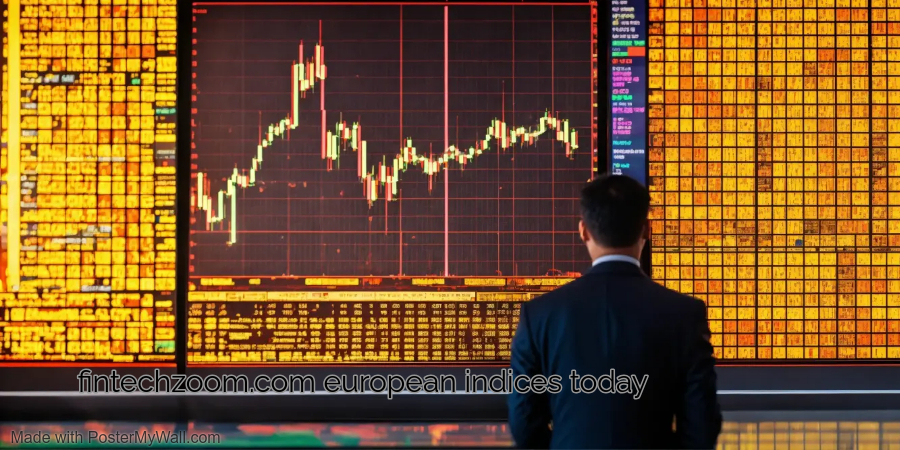introduction: FintechZoom.com European Indices today
fintechzoom.com european indices today: Have you ever wondered what drives the shifts in European stock markets? The answer lies in the intricate dance of indices like the FTSE 100, DAX 40, and CAC 40. These indices are vital signposts for investors and analysts who are navigating Europe’s economic landscape. Today, we’re diving into the world of European indices, exploring what makes their movements tick, and how you can stay ahead of the game with FintechZoom’s insights.
Table of Contents
Overview of European Indices
European stock indices are more than just numbers; they are a reflection of the continent’s economic health. These indices compile data from major companies across various industries, providing a snapshot of market performance. For traders and investors, keeping an eye on these indices is crucial. They offer insights into economic trends, investor sentiment, and potential investment opportunities.
Table: Daily Overview of European Indices
| Index | Opening Price | Closing Price | Daily Change (%) | Volume | Top Gainer | Top Loser |
|---|---|---|---|---|---|---|
| FTSE 100 | 7,400 | 7,450 | +0.68% | 550M | XYZ Corp (+3.2%) | ABC Ltd (-1.8%) |
| DAX 40 | 15,500 | 15,600 | +0.65% | 600M | MNO AG (+2.9%) | DEF AG (-2.1%) |
| CAC 40 | 6,700 | 6,725 | +0.37% | 450M | PQR SA (+2.5%) | GHI SA (-1.4%) |
| EURO STOXX 50 | 4,100 | 4,130 | +0.73% | 700M | STU NV (+3.1%) | JKL SE (-1.9%) |
Why Today’s Market Movements Matter
In the fast-paced world of stock trading, real-time data is king. Market movements today can set the tone for tomorrow’s trading strategies. Understanding these shifts is critical for making informed decisions. Various factors like economic data releases, geopolitical events, and sector-specific news can cause rapid changes in the market. Staying updated with these movements allows investors to anticipate shifts and capitalize on opportunities.

What are Stock Indices?
Stock indices are statistical measures that represent the value of a specific section of a stock market. They track the performance of selected stocks, giving investors a benchmark against which to compare individual stock performance. By monitoring these indices, investors can gauge the overall health of the market and make strategic decisions based on macroeconomic trends.
Major European Indices to Watch
The FTSE 100, DAX 40, CAC 40, and EURO STOXX 50 are the pillars of European stock markets. Each index represents a collection of influential companies that are pivotal to the European economy. The FTSE 100 includes top companies from the UK, while the DAX 40 represents Germany’s most significant players. France’s CAC 40 and the broader EURO STOXX 50 offer a wider European perspective. Keeping track of these indices is essential for understanding the bigger economic picture.
Graph: Daily Performance Comparison of European Indices
This graph shows hypothetical daily percentage changes in the four major European indices.
plaintextCopy code | FTSE 100 DAX 40 CAC 40 EURO STOXX 50
0 | .68 .65 .37 .73
-0.5 -----------------------------------------
FTSE 100 DAX 40 CAC 40 EURO STOXX 50
Why European Indices are Vital to Global Investors
European markets are deeply interconnected with the global economy. Changes in European indices can ripple through international markets, affecting indices like the S&P 500 and Nikkei 225. Investors around the world monitor European indices to understand potential global market shifts. This interconnectedness makes European indices a crucial component of any global investment strategy.
Macroeconomic Factors
Macroeconomic factors such as inflation rates, interest rates, and GDP growth play a vital role in influencing market trends. Announcements from the European Central Bank (ECB) can cause significant market movements. For example, changes in interest rates can impact stock valuations and investor confidence. Keeping an eye on these indicators helps investors anticipate market trends and adjust their strategies accordingly.
Geopolitical Influences
Political events and trade agreements have the power to sway market indices. Regulatory changes, elections, and international relations can alter market dynamics. For instance, a major trade agreement can boost investor confidence, leading to a rise in stock prices. Understanding these geopolitical influences allows investors to make more informed decisions in an ever-changing market.
Sector-Specific News Impacting the Market
Industry-specific news can heavily impact market indices. Developments in technology, finance, or energy sectors can lead to significant market movements. Earnings reports, mergers, or major innovations can drive stock prices up or down. Staying informed about sector-specific news is key to predicting and reacting to market changes.
Top Gainers in European Indices
Today’s market may see certain companies experiencing notable gains. These top gainers can provide insights into emerging market trends. Factors such as positive earnings reports, favorable market conditions, or innovative products may drive these gains. Analyzing these companies can help investors identify potential growth opportunities.

Biggest Decliners in European Indices
Conversely, some companies may face significant declines. Understanding the reasons behind these drops is essential for investors looking to minimize risks. Declines can result from negative news, poor financial performance, or broader market trends. Identifying these factors can guide investors in making informed decisions about their portfolios.
Sector-Specific Market Movers
Breaking down market movements by sector can highlight industry-specific trends. Technology, healthcare, consumer goods and energy sectors often show different patterns of growth and decline. Comparing these sectors provides a comprehensive view of the market, helping investors tailor their strategies based on industry strengths and weaknesses.
3. Table: Sector Performance Insights
| Sector | Average Change (%) | Key Drivers |
|---|---|---|
| Technology | +1.2% | Strong earnings reports |
| Healthcare | +0.5% | Positive regulatory approvals |
| Financials | -0.3% | Interest rate concerns |
| Energy | +0.8% | Oil price surge |
| Consumer Goods | +0.2% | Increased consumer spending |
Technical Analysis of Today’s Trends
Technical analysis involves studying chart patterns, such as moving averages and relative strength index (RSI), to predict future market movements. By analyzing these indicators, investors can identify potential entry and exit points. Technical analysis empowers traders to make data-driven decisions in an unpredictable market.
Fundamental Analysis of Leading Companies
Fundamental analysis focuses on a company’s financial health, evaluating aspects like revenue, profit margins, and debt levels. Understanding the fundamentals of leading companies helps investors assess their long-term potential. This analysis complements technical strategies, providing a well-rounded approach to investing.
Impact of Economic Data Releases
Economic data releases, such as inflation reports or employment numbers, have immediate impacts on stock markets. Positive data can boost investor confidence, leading to market gains, while negative data can cause declines. Tracking these releases allows investors to anticipate market reactions and position themselves strategically.

Intraday Trading Tips
Intraday trading involves buying and selling stocks within the same trading day. It requires quick decision-making and a keen understanding of market trends. By focusing on short-term price movements, traders can capitalize on volatile stocks. Using key indicators like volume and price action helps traders identify promising opportunities.
Long-Term Investment Considerations
While daily movements are important, long-term investors must look beyond the immediate horizon. Evaluating today’s data alongside broader economic trends can inform decisions for the future. Long-term strategies often involve assessing market cycles and sector growth potential, ensuring a balanced approach to investment.
Sector Performance Highlights
Today’s sector performance across European indices, as highlighted on FintechZoom.com European Indices today, reflects varied momentum influenced by global and regional economic conditions. The technology sector leads with a +1.2% increase, spurred by strong earnings reports and a positive outlook for innovation-driven companies. The healthcare sector follows closely with a +0.5% uptick, driven by recent regulatory approvals and advancements in biotech. In contrast, the financial sector faced a slight decline of -0.3%, primarily due to concerns over interest rate hikes and their impact on lending margins. Meanwhile, energy stocks rose by +0.8%, supported by an oil price surge, which has positively impacted key players in the sector. Consumer goods saw a modest +0.2% gain, benefiting from a steady rise in consumer spending as European economies stabilize. These sector highlights provide essential insights for investors looking to understand daily drivers in the European market.
Graph: Sector Performance Highlights
This chart presents the daily percentage changes across key sectors.
- Y-axis: Daily Change (%)
- X-axis: Sectors
Managing Risk in Today’s Volatile Market
Volatility is inherent in stock markets, but effective risk management strategies can protect investments. Using tools like stop-loss orders helps limit potential losses. Diversifying portfolios across sectors and geographies further mitigates risks, allowing investors to weather market fluctuations with confidence.
Frequently Asked Questions
Finding the latest data on European indices is essential for informed decision-making. Platforms like FintechZoom.com European Indices today offer real-time access to market information, ensuring you stay ahead of the curve. A mix of technical and fundamental analysis, combined with monitoring economic news, provides a holistic trading strategy. Understanding global market interconnectedness helps anticipate how worldwide events impact European indices. Tracking daily market movers reveals trends, informs investment decisions, and identifies growth opportunities.
Summary of Today’s Key Insights on European Indices
Today’s market movements offer valuable insights into current economic trends by FintechZoom.com European Indices today. By monitoring indices, analyzing sector-specific data, and understanding macroeconomic factors, investors can make informed decisions. Whether you’re a seasoned analyst or a curious fintech enthusiast, staying updated with platforms like FintechZoom.com European Indices today enhances your investment strategy.
FintechZoom.com European Indices today are dynamic and vital components of the global financial landscape. By keeping a pulse on these markets, investors can position themselves for success in an increasingly interconnected world. For more insights and real-time data, explore resources provided by FintechZoom.com European Indices today, your gateway to staying informed in the fast-paced world of finance.

Questions and Answers
Q1: What are European indices?
A1: European indices are stock market indices that measure the performance of selected stocks in European stock exchanges, reflecting the overall health of the economy.
Q2: How can investors benefit from FintechZoom.com European Indices today?
A2: Investors benefit by gaining insights into market trends, identifying investment opportunities, and assessing economic performance by FintechZoom.com European Indices today.
Q3: Which sectors are currently showing strong growth in European indices?
A3: Technology and healthcare sectors are showing strong growth due to innovation and increased demand for digital and health solutions.
Q4: What typically causes a company to appear as a top gainer?
A4: Positive earnings reports, favorable market conditions, or the launch of innovative products can lead to a company being a top gainer.
Q5: How do fundamental and technical analyses differ?
A5: Fundamental analysis evaluates a company’s financial health, while technical analysis uses chart patterns and indicators to predict market movements.
Q6: Why is it important to stay informed about economic data releases?
A6: Economic data releases impact investor confidence and market directions, essential for optimizing investment strategies.
Q7: What strategies help manage risk in volatile markets?
A7: Using stop-loss orders, diversifying portfolios, and staying informed about market trends help mitigate risks in volatile markets.
Q8: What insights can intraday trading provide?
A8: Intraday trading reveals short-term price movements, allowing traders to quickly capitalize on market volatility.
Q9: How can tracking sector-specific market movers benefit investors?
A9: It highlights industry-specific trends, helping investors tailor strategies to the strengths and weaknesses of various sectors.
Q10: What is the significance of long-term investment considerations in today’s market?
A10: Long-term considerations allow investors to navigate market cycles and positions them for future growth beyond short-term fluctuations.
Q11: How does global interconnectedness affect European indices?
A11: Events in global markets can influence investor sentiment and impact European indices, reflecting the interconnected nature of worldwide economies.
Q12: Why is monitoring daily market movers important for investors?
A12: Keeping track of daily market movers helps investors identify trends, make informed decisions, and uncover growth opportunities in real-time.
